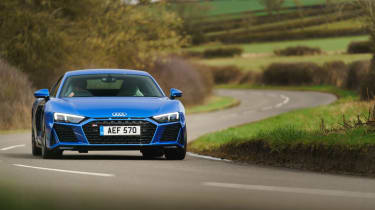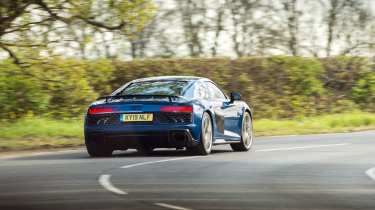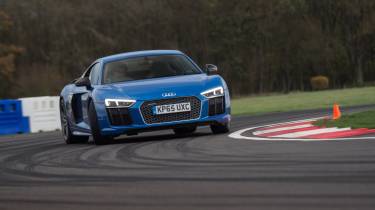Audi R8 review – ride and handling
Huge grip and adjustability make the R8 as sweet to drive as ever, with the hardcore GT RWD adding more bite and precision
The approachable nature of all R8s is no more apparent than when on the road. Despite the supercar shape, the relatively upright windscreen and low scuttle make it an easy car to place, whether on a narrow, winding B-road or inner-city street.
Up the pace and the R8’s friendly demeanour remains, inspiring confidence even when you begin to explore the full firepower on tap. The steering was a real point of criticism for early examples of the second-generation R8. Although not feelsome, the racks of the newer cars are more accurate and faithful to inputs than previous dynamic steering racks. The steering of all R8s is susceptible to tyre pressure variation and temperatures, requiring just the right circumstances to feel properly keyed into the road surface.
Unleash the full potential of the V10 though and the chassis’ underlying balance comes to the fore, making the R8 friendlier than any 500-600bhp mid-engined supercar should be. Thanks to the gradual build of torque, the R8 always feels manageable, helping you meter in power delicately enough to keep within the front axle’s grip threshold. Obviously, a certain safety net is missing in the rear-driven cars but the R8’s sense of balance and clearly-communicated limits remains.
More reviews
Group tests
In-depth reviews
Reviews
- Audi R8 Spyder (2016 - 2024) review – that V10 in surround sound
- Audi R8 V10 RWD and R8 RWD Performance (2020 - 2024) review – Audi's 911 GT3 fighters
- Audi R8 V10 GT RWD (2022 - 2024) review – the R8 bows out in spectacular style
- Audi R8 4.2 FSI V8 quattro (2007 - 2015): review, history and specs of an icon
All R8s are wide, so at road-friendly speeds they lack a Vantage’s playfulness, or a 911’s ultimate precision. Get them on track though and you’re able to more flamboyantly explore the R8’s limits, as we found out over six months of trackdays with our previous R8 Performance long-termer.
On a circuit the R8 – be it rear or four-wheel-drive – can be coaxed into a drift, thanks in part to the locking differential in the rear axle. In standard cars, the four-wheel-drive system shuffles torque to arrest an initial slide if you do pitch it in early, so mid-corner you can have the car practically pointing straight again – great if you want a quick exit.
Be brutal with the throttle in the latter part of a corner and you can instigate another slide as you peel away from the apex. It does allow the R8 to be wild and playful when you want it to, it just doesn’t allow long and continuous drifts, and that’s hardly an issue. The limits are high, though, requiring more commitment to reach and surpass and more focus to really enjoy. Second-gen R8s simply don’t have the malleability of the first-generation cars.
The RWD GT run-out special takes a significant step forward on a circuit, particularly when specified with Audi's adjustable coilover suspension kit. It turns in with more bite and its Michelin Cup 2 tyres find more traction, but you can fully explore the GT's rear-drive balance by using its bespoke Torque Rear drive mode.
Offering 7 levels of electronic intervention, the system allows the rear to smoothly break away under power, with the more lenient settings enabling large drift angles. The GT is more urgent and accelerative thanks to its shorter gear ratios, too, and it feels organic and approachable where newer alternatives from Ferrari and Porsche can feel a touch hyper active at times.
The carbon ceramic brakes, which were a £7700 option on the RWD model and were standard fit on the Quattro, do offer very strong retardation with decent pedal feel and progression, but they did begin to fade on track after a handful of quick laps. On the road there’s a minor perceptible difference between the two brake options, the steel brakes offering just as much stopping power as the carbon ceramics. However, the ceramic brakes did resist triggering the ABS on rougher roads better than the steel ones.
Audi’s Drive Select system allows the driver to choose between various parameters for the engine, dampers (if you have the adaptive option) and steering (if you have the dynamic rack). Independent adjustability will suit some as it widens the car’s operating window. Some will appreciate the focus of more ‘passive’ examples. Either way, this really is a supercar that can be used everyday thanks to its refinement, relatively pliant ride, cabin quality and front stowage compartment.
The R8 can further be adjusted for the prevailing conditions via the performance mode dial on the steering wheel, which allows the driver to choose between wet, dry and snow and ice settings.





